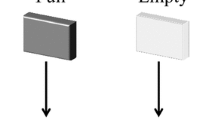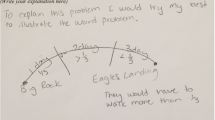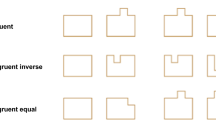Abstract
It is well known that many students encounter difficulties when solving problems in mathematics. Research indicates that some of these difficulties may stem from intuitive interference with formal/logical reasoning. Our research aims at deepening the understanding of these difficulties and their underlying reasoning mechanisms to help students overcome them. For this purpose we carried out behavioral, brain imaging and intervention studies focusing on a previously demonstrated obstacle in mathematics education. The literature reports that many students believe that shapes with a larger area must have a larger perimeter. We measured the accuracy of responses, reaction time, and neural correlates (by fMRI) while participants compared the perimeters of geometrical shapes in two conditions: (1) congruent, in which correct response was in line with intuitive reasoning (larger area–larger perimeter) and (2) incongruent, in which the correct answer was counterintuitive. In the incongruent condition, accuracy dropped and reaction time for correct responses was longer than in the congruent condition. The congruent condition activated bilateral parietal brain areas, known to be involved in the comparison of quantities, while correctly answering the incongruent condition activated bilateral prefrontal areas known for their executive control over other brain regions. The intervention, during which students’ attention was drawn to the relevant variable, increased accuracy in the incongruent condition, while reaction times increased in both congruent and incongruent conditions. The findings of the three studies point to the importance of control mechanisms in overcoming intuitive interference in mathematics. Overall, it appears that adding a cognitive neuroscience perspective to mathematics education research can contribute to a better understanding of students’ difficulties and reasoning processes. Such information is important for educational research and practice.







Similar content being viewed by others
References
Aron, A. R., Robbins, T. W., & Poldrack, R. A. (2004). Inhibition and the right inferior frontal cortex. Trends in Cognitive Sciences, 8, 170–177.
Babai, R. (2010). Piagetian cognitive level and the tendency to use intuitive rules when solving comparison tasks. International Journal of Science and Mathematics Education, 8, 203–221.
Babai, R., & Amsterdamer, A. (2008). The persistence of solid and liquid naive conceptions: A reaction time study. Journal of Science Education and Technology, 17, 553–559.
Babai, R., Brecher, T., Stavy, R., & Tirosh, D. (2006a). Intuitive interference in probabilistic reasoning. International Journal of Science and Mathematics Education, 4, 627–639.
Babai, R., Levyadun, T., Stavy, R., & Tirosh, D. (2006b). Intuitive rules in science and mathematics: A reaction time study. International Journal of Mathematical Education in Science and Technology, 37, 913–924.
Babai, R., Sekal, R., & Stavy, R. (2010a). Persistence of the intuitive conception of living things in adolescence. Journal of Science Education and Technology, 19, 20–26.
Babai, R., Zilber, H., Stavy, R., & Tirosh, D. (2010b). The effect of intervention on accuracy of students’ responses and reaction times to geometry problems. International Journal of Science and Mathematics Education, 8, 185–201.
Deliyianni, E., Michael, E., & Pitta-Pantazi, D. (2006). The effect of different teaching tools in overcoming the impact of the intuitive rules. In J. Novotná, H. Moraová, M. Krátká, & N. Stehlíková (Eds.), Proceedings 30th conference of the international group for the psychology of mathematics education (Vol. 2, pp. 409–416). Prague: PME.
Dembo, Y., Levin, I., & Siegler, R. S. (1997). A comparison of the geometric reasoning of students attending Israeli ultraorthodox and mainstream schools. Developmental Psychology, 33, 92–103.
Dempster, F. N., & Corkill, A. J. (1999). Interference and inhibition in cognition and behavior: Unifying themes for educational psychology. Educational Psychology Review, 11, 1–88.
Denes, G., & Pizzamiglio, L. (1999). Handbook of clinical and experimental neuropsychology (pp. 28–30). Hove, UK: Psychology Press.
Faw, B. (2003). Pre-frontal executive committee for perception, working memory, attention, long-term memory, motion control, and thinking: A tutorial review. Consciousness and Cognition, 12, 83–139.
Fias, W., Lammertyn, J., Reynvoet, B., Dupont, P., & Orban, G. A. (2003). Parietal representation of symbolic and nonsymbolic magnitude. Journal of Cognitive Neuroscience, 15, 47–56.
Gillard, E., Van Dooren, W., Schaeken, W., & Verschaffel, L. (2009). Dual-processes in the psychology of mathematics education and cognitive psychology. Human Development, 52, 95–108.
Goel, V., Makale, M., & Grafman, J. (2004). The hippocampal system mediates logical reasoning about familiar spatial environments. Journal of Cognitive Neuroscience, 16, 654–664.
Henik, A., & Tzelgov, J. (1982). Is three greater than five: The relation between physical and semantic size in comparison tasks. Memory and Cognition, 10, 389–395.
Hoffer, A. R., & Hoffer, S. A. K. (1992). Geometry and visual thinking. In R. Post (Ed.), Teaching mathematics in grades K-8: Research-based methods (2nd ed.). Boston: Allyn and Bacon.
Houde, O., & Guichart, E. (2001). Negative priming effect after inhibition of number/length interference in a Piaget-like task. Developmental Science, 4, 119–123.
Houde, O., Zago, L., Mellet, E., Moutier, S., Pineau, A., Mazoyer, B., et al. (2000). Shifting from the perceptual brain to the logical brain: The neural impact of cognitive inhibition training. Journal of Cognitive Neuroscience, 12, 721–728.
Konishi, S., Nakajima, K., Uchida, I., Kikyo, H., Kameyama, M., & Miyashita, Y. (1999). Common inhibitory mechanism in human inferior prefrontal cortex revealed by event-related functional MRI. Brain, 122, 981–991.
Lavie, N. (2005). Distracted and confused?: Selective attention under load. Trends in Cognitive Sciences, 9, 75–82.
Lavie, N., Hirst, A., de Fockert, J. W., & Viding, E. (2004). Load theory of selective attention and cognitive control. Journal of Experimental Psychology: General, 133, 339–354.
Moutier, S., Angeard, N., & Houde, O. (2002). Deductive reasoning and matching-bias inhibition training: Evidence from a debiasing paradigm. Thinking and Reasoning, 8, 205–224.
Moutier, S., & Houde, O. (2003). Judgement under uncertainty and conjunction fallacy inhibition training. Thinking and Reasoning, 9, 185–201.
Pinel, P., Piazza, M., Le Bihan, D., & Dehaene, S. (2004). Distributed and overlapping cerebral representations of number, size, and luminance during comparative judgments. Neuron, 41, 983–993.
Rogers, R. D., Owen, A. M., Middleton, H. C., Williams, E. J., Pickard, J. D., Sahakian, B. J., et al. (1999). Choosing between small, likely rewards and large, unlikely rewards activates inferior and orbital prefrontal cortex. The Journal of Neuroscience, 20, 9029–9038.
Schoenfeld, A. H. (1985). Mathematical problem solving. New York: Academic Press.
Shultz, T., Dover, A., & Amsel, E. (1979). The logical and empirical bases of conservation judgments. Cognition, 7, 99–123.
Stavy, R., & Babai, R. (2008). Complexity of shapes and quantitative reasoning in geometry. Mind, Brain, and Education, 2, 170–176.
Stavy, R., Babai, R., Tsamir, P., Tirosh, D., Lin, F., & McRobbie, C. (2006a). Are intuitive rules universal? International Journal of Science and Mathematics Education, 4, 417–436.
Stavy, R., Goel, V., Critchley, H., & Dolan, R. (2006b). Intuitive interference in quantitative reasoning. Brain Research, 1073–1074, 383–388.
Stavy, R., & Tirosh, D. (1996). Intuitive rules in science and mathematics: The case of ‘more of A - more of B’. International Journal of Science Education, 18, 653–667.
Stavy, R., & Tirosh, D. (2000). How students (mis-)understand science and mathematics. New York: Teachers College Press.
Stroop, R. J. (1935). Studies of interference in serial verbal reactions. Journal of Experimental Psychology, 18, 643–662.
Tang, J., Critchley, H. D., Glaser, D. E., Dolan, R. J., & Butterworth, B. (2006). Imaging informational conflict: A functional magnetic resonance imaging study of numerical Stroop. Journal of Cognitive Neuroscience, 18, 2049–2062.
Tirosh, D., & Stavy, R. (1999). Intuitive rules and comparison tasks. Mathematical Thinking and Learning, 1, 179–194.
Walter, N. (1970). A common misconception about area. Arithmetic Teacher, 17, 286–289.
Woodward, E., & Byrd, F. (1983). Area: Included topic, neglected concept. School Science and Mathematics, 83, 343–347.
Zazkis, R. (1999). Intuitive rules in number theory: Example of ‘the more of A, the more of B’ rule implementation. Educational Studies in Mathematics, 40, 197–209.
Author information
Authors and Affiliations
Corresponding author
Rights and permissions
About this article
Cite this article
Stavy, R., Babai, R. Overcoming intuitive interference in mathematics: insights from behavioral, brain imaging and intervention studies. ZDM Mathematics Education 42, 621–633 (2010). https://doi.org/10.1007/s11858-010-0251-z
Accepted:
Published:
Issue Date:
DOI: https://doi.org/10.1007/s11858-010-0251-z




